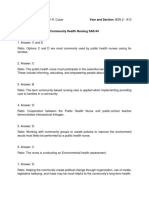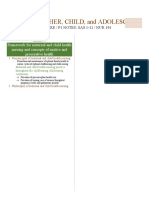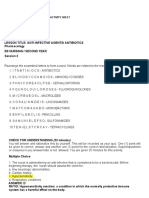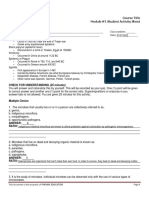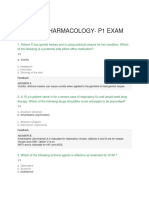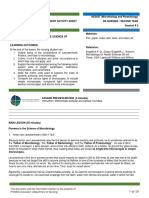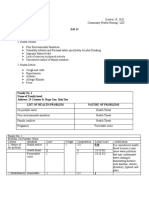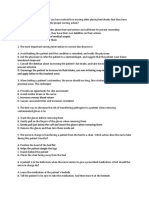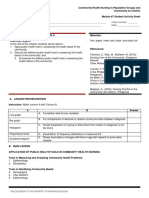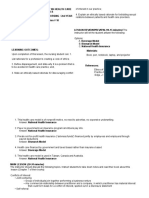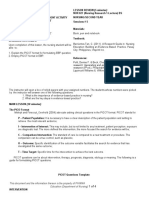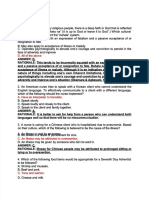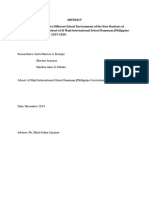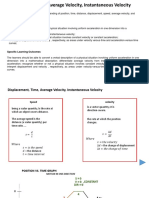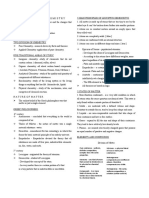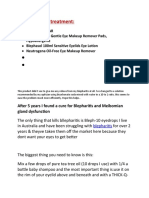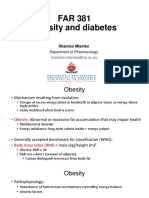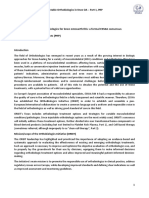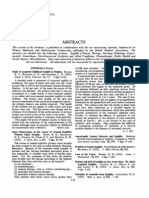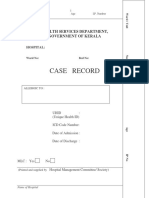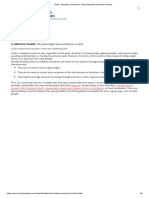HES 032 - SAS 1 - Merged-1
HES 032 - SAS 1 - Merged-1
Uploaded by
bangtanswifue -Copyright:
Available Formats
HES 032 - SAS 1 - Merged-1
HES 032 - SAS 1 - Merged-1
Uploaded by
bangtanswifue -Original Title
Copyright
Available Formats
Share this document
Did you find this document useful?
Is this content inappropriate?
Copyright:
Available Formats
HES 032 - SAS 1 - Merged-1
HES 032 - SAS 1 - Merged-1
Uploaded by
bangtanswifue -Copyright:
Available Formats
CARLA MARISSE A.
ESCARPE HES 032 - MODULE #1
BSN 2 - A14
CHECK FOR UNDERSTANDING
1. The microbes that usually live on or in a person are collectively referred to as:
a. germs.
b. indigenous microflora.
c. nonpathogens.
d. opportunistic pathogens.
RATIO: It has been estimated that perhaps as many as 500 to 1,000 different species of microbes live on and in us which is
collectively known as indigenous microflora or indigenous microbiota.
2. Microbes that live on dead and decaying organic material is known as:
a. indigenous microflora.
b. parasites.
c. pathogens.
d. saprophytes.
RATIO: Many microbes are involved in the decomposition of dead organisms and the waste products of living organism which is
collectively known as decomposers or saprophytes.
3. It is the study of microbes. Individual microbes can be observed only with the use of various types of microscopes.
a. microbiology
b. virology
c. parasitology
d. protozoology
RATIO: Microbiology is the study of the biology of microscopic organisms - viruses, bacteria, algae, fungi, slime molds, and
protozoa.
4. These are also called infectious particles. These microbes include viruses and prions.
a. cellular Microbes
b. prokaryotes
c. eukaryotes
d. acellular Microbes
RATIO: Viruses and prions are acellular microorganisms, which means they are not composed of cells.
5. These are also called microorganisms. It includes all bacteria, all archaea, some algae, all protozoa, and some fungi
a. cellular Microbes
b. prokaryotes
c. eukaryotes
d. acellular Microbes
RATIO: Cellular microbes include bacteria, the archaea, the fungi, and the protists. Cellular microbes can be either unicellular or
multicellular.
6. This do not cause disease under ordinary conditions but have the potential to cause disease should the opportunity present
itself.
a. pathogens
b. opportunistic infection
c. indigenous Microbiota
d. fastidious microbes
RATIO: Opportunistic pathogens do not cause disease under ordinary conditions, but have the potential to cause disease should
the opportunity present itself.
7. This kind of pathogen colonizes on the host body and cause a certain disease.
a. infectious Disease
b. microbial Intoxication
c. pathogen
d. non-pathogen
RATIO: Disease-causing microorganisms are technically known as pathogens also known as infectious agents.
8. A pathogen produces a toxin in vitro. A person ingests the toxin and the toxin causes a disease.
a. infectious Disease
b. microbial Intoxication
You might also like
- CHN Sas 1 23 AnswersDocument70 pagesCHN Sas 1 23 AnswersKim Dino Olimpo Serrano100% (3)
- Nutri Lab P1p2rbe Exam 2 2Document16 pagesNutri Lab P1p2rbe Exam 2 2SandyNo ratings yet
- Nutrition Modules 1 23 Laboratory 1Document53 pagesNutrition Modules 1 23 Laboratory 1Chelsy Sky SacanNo ratings yet
- HEDocument20 pagesHEJhay-r BaldoNo ratings yet
- Nur 194 Sas 1Document2 pagesNur 194 Sas 1Orange Alvarez100% (1)
- Statement of Deficiencies and Plan of Correction For Andbe Home (Via DHHS)Document12 pagesStatement of Deficiencies and Plan of Correction For Andbe Home (Via DHHS)NTV NewsNo ratings yet
- NCP HypertensionDocument2 pagesNCP Hypertensionsinister1781% (27)
- HES 032 - SAS 1 - Merged-3Document1 pageHES 032 - SAS 1 - Merged-3bangtanswifue -No ratings yet
- HES 032 - SAS 1 - Merged-2Document1 pageHES 032 - SAS 1 - Merged-2bangtanswifue -No ratings yet
- HES007 Lab Session #19 SASDocument8 pagesHES007 Lab Session #19 SASJemimah GraceNo ratings yet
- HES 005 Session 5 SASDocument10 pagesHES 005 Session 5 SASG INo ratings yet
- HES007 Lec Session #1 SASDocument7 pagesHES007 Lec Session #1 SASPresley Joy Graneta RamosNo ratings yet
- Micro Lec Ars Sessions 17 23Document9 pagesMicro Lec Ars Sessions 17 23rica sebabillonesNo ratings yet
- Jerson Jeck AlcidoDocument5 pagesJerson Jeck AlcidoJerson Jeck Salumanda AlcidoNo ratings yet
- Microbio LEC SAS 2Document3 pagesMicrobio LEC SAS 2spooderm4n100% (1)
- Cubar - CHN Sas #4Document2 pagesCubar - CHN Sas #4Wilson Emmanuel CubarNo ratings yet
- Nur 195 Long Exam P2 Rle 1 - 1Document21 pagesNur 195 Long Exam P2 Rle 1 - 1Marga WreatheNo ratings yet
- ENG 189 SAS#9 Listening 2324Document12 pagesENG 189 SAS#9 Listening 2324Jonah Marindoque BalicocoNo ratings yet
- SAS #13 Listening ENG189 Swu (Signed) 111Document9 pagesSAS #13 Listening ENG189 Swu (Signed) 111flowerpower100% (1)
- Nur 194 - Care of Mother, Child, & AdolescentDocument43 pagesNur 194 - Care of Mother, Child, & AdolescentAileen Cagulada100% (2)
- SAS-3 Writing ENG189Document8 pagesSAS-3 Writing ENG189Lyons Schimtt100% (1)
- Pharma Module 3Document4 pagesPharma Module 3Chelsy Sky Sacan100% (1)
- CFU 1 23 MERGED Sd-1phrmaDocument105 pagesCFU 1 23 MERGED Sd-1phrmaAdrian “Skylark” BenavidezNo ratings yet
- Session #1 SAS - Nutrition (Lecture)Document11 pagesSession #1 SAS - Nutrition (Lecture)Mariel Gwen RetorcaNo ratings yet
- Reviewer Notes For MCN Lec Sas 9 To 16Document16 pagesReviewer Notes For MCN Lec Sas 9 To 16zyyw.abello.uiNo ratings yet
- Bioethics Session 8 SASDocument6 pagesBioethics Session 8 SASAnthony BadiliNo ratings yet
- HES 005 Session 6 SASDocument10 pagesHES 005 Session 6 SASG INo ratings yet
- Hes 005 Session 16 SasDocument7 pagesHes 005 Session 16 SasJose Melmar Autida AutenticoNo ratings yet
- Micro Lec A&rs Sessions 9 - 16Document16 pagesMicro Lec A&rs Sessions 9 - 16rica sebabillonesNo ratings yet
- Birao Sas 11 Microbiology and ParasitologyDocument10 pagesBirao Sas 11 Microbiology and ParasitologyFrancis Jacob Dejecacion GarcesNo ratings yet
- Answer Key NUR 194 CompiledDocument49 pagesAnswer Key NUR 194 CompiledArellano Laurence100% (1)
- Microbio LEC SAS 1Document3 pagesMicrobio LEC SAS 1spooderm4nNo ratings yet
- Birao Sas 13 Microbiology and ParasitologyDocument9 pagesBirao Sas 13 Microbiology and ParasitologyFrancis Jacob Dejecacion GarcesNo ratings yet
- P3 LONG QUIZ Nutri LecDocument16 pagesP3 LONG QUIZ Nutri Lecspes.paasa.cocNo ratings yet
- Hes 005 - Pharmacology-P1 Exam: Total PointsDocument18 pagesHes 005 - Pharmacology-P1 Exam: Total PointsMaria OgabangNo ratings yet
- HES007 Lec Session #2 SASDocument10 pagesHES007 Lec Session #2 SASPresley Joy Graneta RamosNo ratings yet
- HES007 Lab Session #16 SASDocument6 pagesHES007 Lab Session #16 SASJoan SinutoNo ratings yet
- Hes 008 - Sas 2Document2 pagesHes 008 - Sas 2AIRJSY100% (1)
- ENG 189 SAS#6 Reading 2324Document6 pagesENG 189 SAS#6 Reading 2324JAPHETTE ESGANANo ratings yet
- Sas 15 MCN Lec 2Document3 pagesSas 15 MCN Lec 2Jhoanna Marie VillaverdeNo ratings yet
- Funda Sas4Document2 pagesFunda Sas4Jhan Veaver Lee Estrera MarquezNo ratings yet
- Sas 1 25 2Document31 pagesSas 1 25 2KIMBERLY CABATONo ratings yet
- Gen 017 - Sas Lesson #1Document2 pagesGen 017 - Sas Lesson #1Faith CalimlimNo ratings yet
- Sas 15Document5 pagesSas 15Kristinelou Marie ReynaNo ratings yet
- 30 Items For Funda RLE p2Document6 pages30 Items For Funda RLE p2phoebjaetanNo ratings yet
- Nur 194 Sas 2Document2 pagesNur 194 Sas 2Orange AlvarezNo ratings yet
- Health Assessment SAS Session 14Document9 pagesHealth Assessment SAS Session 14Maria Jub MangrubanNo ratings yet
- Lab #9 Nur 102Document2 pagesLab #9 Nur 102Bernadeth Barrientos ZamoraNo ratings yet
- Session #17 SAS - Nutrition (Lecture)Document10 pagesSession #17 SAS - Nutrition (Lecture)cabo.bontilao.swuNo ratings yet
- CHN 2 Session 7 SASDocument9 pagesCHN 2 Session 7 SASrica sebabillonesNo ratings yet
- HES007 Lec Session #5 SASDocument9 pagesHES007 Lec Session #5 SASPresley Joy Graneta RamosNo ratings yet
- Lab Sas 12 NUR 102Document1 pageLab Sas 12 NUR 102Bernadeth Barrientos ZamoraNo ratings yet
- P2 Nutri Lec Rationalization Activity 9Document14 pagesP2 Nutri Lec Rationalization Activity 9Kimberly Anne Capiral Nunog100% (1)
- Sas 6Document2 pagesSas 6chantoy bersalesNo ratings yet
- Sas 12-15Document6 pagesSas 12-15Lyons SchimttNo ratings yet
- Session #2 SAS - Nutrition (Lecture)Document7 pagesSession #2 SAS - Nutrition (Lecture)Mariel Gwen RetorcaNo ratings yet
- Mae Ann Oliva Valic - BIOETHICS SAS10Document5 pagesMae Ann Oliva Valic - BIOETHICS SAS10Mae Ann Oliva ValicNo ratings yet
- SAS Session 5 Research 1Document4 pagesSAS Session 5 Research 1Leaflor Ann ManghihilotNo ratings yet
- Cmca-Rle P2Document18 pagesCmca-Rle P2Angelo BiluanNo ratings yet
- Nur 192 CHN Lec Session 1 23Document70 pagesNur 192 CHN Lec Session 1 23James Eugene CaasiNo ratings yet
- ENG 189 SAS#5 Listening 2324Document13 pagesENG 189 SAS#5 Listening 2324JAPHETTE ESGANANo ratings yet
- BIO 225 Chapter 1 Notes and Important TermsDocument3 pagesBIO 225 Chapter 1 Notes and Important TermsTimur DmitriyevNo ratings yet
- HES 032 - SAS 1 - Merged-4Document1 pageHES 032 - SAS 1 - Merged-4bangtanswifue -No ratings yet
- HES 032 - SAS 1 - Merged-5Document1 pageHES 032 - SAS 1 - Merged-5bangtanswifue -No ratings yet
- Chapter Assesment 2 (Gen-Chem)Document1 pageChapter Assesment 2 (Gen-Chem)bangtanswifue -No ratings yet
- UCSP Reviewer - FinalsDocument1 pageUCSP Reviewer - Finalsbangtanswifue -No ratings yet
- 465 Homosexualmarriage 2Document2 pages465 Homosexualmarriage 2bangtanswifue -No ratings yet
- Philippine: Al Majd Fntemational CurriculumDocument1 pagePhilippine: Al Majd Fntemational Curriculumbangtanswifue -No ratings yet
- Center of MassDocument1 pageCenter of Massbangtanswifue -No ratings yet
- General Chemistry NotesDocument6 pagesGeneral Chemistry Notesbangtanswifue -No ratings yet
- Personal Statement: Adm-Adm 07F Documented Information Effective March 1, 2021Document4 pagesPersonal Statement: Adm-Adm 07F Documented Information Effective March 1, 2021bangtanswifue -No ratings yet
- 3.1.3 CM Cardboard 04dkDocument6 pages3.1.3 CM Cardboard 04dkbangtanswifue -No ratings yet
- Pre-Conquest PeriodDocument6 pagesPre-Conquest Periodbangtanswifue -No ratings yet
- The Three Following Requirements of Academic WritingDocument3 pagesThe Three Following Requirements of Academic Writingbangtanswifue -No ratings yet
- Frances Reyes AquinoDocument2 pagesFrances Reyes Aquinobangtanswifue -No ratings yet
- CHAPTER III New StudentsDocument3 pagesCHAPTER III New Studentsbangtanswifue -No ratings yet
- 1421-Article Text-5000-1-10-20161030Document10 pages1421-Article Text-5000-1-10-20161030bangtanswifue -No ratings yet
- National Artist For MusicDocument2 pagesNational Artist For Musicbangtanswifue -No ratings yet
- ABSTRACTDocument2 pagesABSTRACTbangtanswifue -No ratings yet
- Displacement, Time, Average Velocity, Instantaneous VelocityDocument13 pagesDisplacement, Time, Average Velocity, Instantaneous Velocitybangtanswifue -100% (1)
- Vector Simplified SDocument15 pagesVector Simplified Sbangtanswifue -No ratings yet
- Worksheet Uniform Circular MotionDocument1 pageWorksheet Uniform Circular Motionbangtanswifue -No ratings yet
- Fall Semester Review KEYDocument8 pagesFall Semester Review KEYbangtanswifue -No ratings yet
- Example of Instantaneous VelocityDocument5 pagesExample of Instantaneous Velocitybangtanswifue -No ratings yet
- Introduction To ChemistryDocument2 pagesIntroduction To Chemistrybangtanswifue -No ratings yet
- After 5 Years I Found A Cure For Blepharitis and Meibomian Gland DysfunctionDocument23 pagesAfter 5 Years I Found A Cure For Blepharitis and Meibomian Gland Dysfunctionbarney_bestNo ratings yet
- Obesity and DiabetesDocument41 pagesObesity and DiabetesHuzaifa KhanNo ratings yet
- Sri Chaitanya Educational Institutions, India.: Important InstructionsDocument26 pagesSri Chaitanya Educational Institutions, India.: Important Instructionsbal_thakreNo ratings yet
- Cellulitis: Clinical Review: Be The First To CommentDocument9 pagesCellulitis: Clinical Review: Be The First To CommentAnonymous 1nMTZWmzNo ratings yet
- Review of Related LiteratureDocument9 pagesReview of Related LiteratureMarion Joy GanayoNo ratings yet
- Biological Warfare Attack, Diagnosis, TreatmentDocument41 pagesBiological Warfare Attack, Diagnosis, Treatmentapi-3695725No ratings yet
- Iqvia Launch Excellence For Multi Indication Assets 02 23 ForwebDocument20 pagesIqvia Launch Excellence For Multi Indication Assets 02 23 ForwebsethirohinNo ratings yet
- Test-25 (Current Affair-3) PDFDocument59 pagesTest-25 (Current Affair-3) PDFGaurav SahuNo ratings yet
- Dr. Susatyo Pramono Hadi, SP.SDocument33 pagesDr. Susatyo Pramono Hadi, SP.SChristian ThamNo ratings yet
- Tle 10Document3 pagesTle 10Aldrin BagasinaNo ratings yet
- Oral Care in ICUDocument8 pagesOral Care in ICUYani Va-Rhy100% (1)
- httpssamagra.kite.kerala.gov.infilessamagra-resourceuploadstbookscmqVOL1STD8BasicScienceEnglishBasicScienceEnglish.pdDocument159 pageshttpssamagra.kite.kerala.gov.infilessamagra-resourceuploadstbookscmqVOL1STD8BasicScienceEnglishBasicScienceEnglish.pdelectrotech156No ratings yet
- 001 Hilton Dr. Directory 2Document20 pages001 Hilton Dr. Directory 2Muhammad Siraj KhanNo ratings yet
- Anexo 3 Consenso de La Eskka en OsteoartritisDocument58 pagesAnexo 3 Consenso de La Eskka en OsteoartritisgrimmNo ratings yet
- CertificateDocument1 pageCertificateJaya ShuklaNo ratings yet
- The Effects of Compost Tea On Golf Course Greens Turf and SoilDocument10 pagesThe Effects of Compost Tea On Golf Course Greens Turf and SoilLeonides Bernardo Fernández LicónNo ratings yet
- Physio B 1.2 Renal Physiology Pt. 4 (Dr. Vila) : Because of Increase Water ReabsorptionDocument5 pagesPhysio B 1.2 Renal Physiology Pt. 4 (Dr. Vila) : Because of Increase Water ReabsorptionAnny AlvrzNo ratings yet
- Unit 8. Vocabulary. Health and Ilnesses Aim: To Deal With Different Types of Categories That Cover The Field of Health and FitnessDocument9 pagesUnit 8. Vocabulary. Health and Ilnesses Aim: To Deal With Different Types of Categories That Cover The Field of Health and FitnessFmga GaNo ratings yet
- Ace The OSCE2 BookDocument126 pagesAce The OSCE2 BookVijay Mg100% (6)
- Androgens and Hair GrowthDocument15 pagesAndrogens and Hair GrowthKarini GonçalvesNo ratings yet
- IGNOU Block 3 Unit 2 Communicable Diseases - Vector Borne DiseasesDocument16 pagesIGNOU Block 3 Unit 2 Communicable Diseases - Vector Borne Diseaseserice.researchNo ratings yet
- SSB GibsonMcElhaneyLtr4.2016 PDFDocument1 pageSSB GibsonMcElhaneyLtr4.2016 PDFRecordTrac - City of OaklandNo ratings yet
- Bacan Stone Is A Kind of Precious StonesDocument3 pagesBacan Stone Is A Kind of Precious StonesRikson TandelilinNo ratings yet
- Histology MCQDocument46 pagesHistology MCQStrive ShashaNo ratings yet
- Abstracts: Brit. J. Vener. Dis. (1956), 32, 131Document5 pagesAbstracts: Brit. J. Vener. Dis. (1956), 32, 131Shaashi DamodaranNo ratings yet
- Model Case RecordDocument30 pagesModel Case RecordAniruddha JoshiNo ratings yet
- You Scored 0 Correct Out of 9 QuestionsDocument3 pagesYou Scored 0 Correct Out of 9 QuestionsTaaliah TariqNo ratings yet
- 8.diets - Disorders of Nutrition - Merck Manuals Consumer VersionDocument6 pages8.diets - Disorders of Nutrition - Merck Manuals Consumer VersionJimmy PetersNo ratings yet















